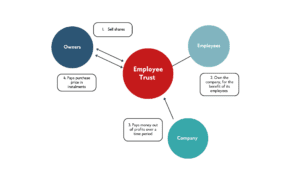A guide to Employee Ownership Trusts
Created by the Finance Act 2014, Employee Ownership Trusts (“EOTs”) can facilitate the transition of ownership of a business to its employees. It was introduced as part of the Government’s efforts to encourage more companies to become employee-owned.
Background to Employee Ownership Trusts
After a slow start, the use of EOTs has become increasingly popular. Currently, there are c.1,650 live EOTs in the UK. Recent high-profile company transitions toward employee-owned businesses via EOT structures include the treetop adventure business Go Ape in 2021, hi-fi retailer Richer Sounds in 2019, and organic veg firm Riverford in 2018.
Whilst the primary goal of EOTs is to transfer ownership to employees, EOTs can be used to secure a tax-favourable exit for owners of UK businesses.
Below, we have listed some EOT transactions during 2023 in the UK.
| Target | Industry | Date |
| Airside Data & Training Ltd | Information technology consultancy | September 2023 |
| Ikonic Technology Limited | Distributor of IT hardware | May 2023 |
| Cardinal Maritime Group Limited | Transportation and logistics | April 2023 |
| Langcliffe International Limited | Europe’s largest M&A buyside deal origination research business | March 2023 |
| Watkin and Sons (Grantham) Limited | Butchers and bakery | March 2023 |
| E.E.N Holdings Limited | Financial planning | March 2023 |
| RR Engineering Limited | Metal fabrication and galvanizing | March 2023 |
| Understanding Recruitment Ltd | Specialist technology software recruitment consultancy | January 2023 |
Source: MarktoMarket
What is an Employee Ownership Trust?
An EOT is a Trust created to hold shares in a company on behalf of its employees, so that they can become the owners (indirectly via the Trust). The current owners sell (a minimum of 50%) of their shares in the company to the EOT at their estimated current market value. Usually, the sale proceeds are paid in cash using the retained profit of the company; any remaining amount is paid out over time using future profits generated by the company and distributed up to the EOT.
Post-sale, the company will continue to generate trading profits each year as normal. The annual profits will be distributed to the Trust who, in turn, can distribute the profits to employees (and use the profits to pay off and sale proceeds still owed to the previous owners).
How is an Employee Ownership Trust run?
An EOT is run by its trustees with the primary aims of: (a) ensuring that the company is being operated appropriately; (b) to oversee the profit-sharing policy; and (c) to maximise employee commitment. We note that it is not the role of the Trust to manage the day-to-day affairs of the company – strategic and operational matters will continue to remain the role of the company’s management.
The trustees will also have control over the appointment and removal of company directors.
How can owners exit via an Employee Ownership Trusts?
- Owner/s sell their shares in the company to the EOT under a Share Purchase Agreement.
- Employees indirectly (via the Trust) own the company, for the benefit of the employees themselves.
- Over time, the company pays money out of trading profits into the Trust.
- The Trust pays the share purchase price in instalments to the owner/s.

Employee Ownership Trust selling price
When an owner sells shares to an EOT, the sales price cannot exceed the market value of the shares.
Unfortunately, HMRC will not discuss or agree the market value prior to a sale to an EOT. It is therefore strongly recommended that an independent expert valuer is engaged to value a company’s shares to ensure that the sales price does not exceed market value.
Profit distributions to employees
Each employee can receive profit distributions of up to £3,600 per tax year from the Trust, free from income tax (NIC still applies). Anything above this amount will be taxable in the way a normal salary is. Profit distributions are all dealt with directly by payroll, so there is no additional administrative burden for staff members to deal with.
Advantages and disadvantages of Employee Ownership Trusts
What are the main advantages of an EOT?
There are several key advantages of an EOT. Firstly, it places the business in the hands of people who understand it the best, ensuring continuity in day-to-day operations. As employees will become entitled to a share in the company’s trading profits post-completion, they will often have a stronger personal commitment to the long-term success of the company and are motivated by ownership to better the company’s performance.
Another key advantage of an EOT is the tax advantaged status they offers. EOTs are extremely tax efficient as no Capital Gains Tax is payable by the sellers on the sale of shares to an EOT. This means that a seller can end up receiving larger net proceeds via a sale to a Trust, rather than alternative exit routes – even if the overall valuation is lower.
Other key advantages of an EOT include:
- Lower transaction costs – EOTs typically have lower transaction costs compared with other common exit options. Although it is necessary to receive HMRC clearance and to establish the overall EOT structure, this is not an extensive or complex process. In addition, the level of required due diligence is significantly lower than other options.
- Low likelihood of failed transaction – The risk of a failed transaction is significantly lower than other common exit options. There is also no need to find and seek a buyer, which significantly simplifies a potential exit.
- Preservation of culture – Company culture and values are more likely to be preserved now that the company is employee-owned.
- Higher staff retention – With a greater personal investment in the company, staff retention will likely be improved. In addition, the company is more attractive to potential new employees.
- Increased productivity – According to the Employee Ownership Association, employee-owned businesses are 8-12% more productive than non-employee-owned businesses.
- Improved corporate governance – The company is placed in the hands of those who understand it the best. This can help to improve corporate governance.
Tax position
An EOT provides the following tax advantages:
| Capital Gains Tax | Tax-free bonus |
| Those selling shares into an EOT are exempt from Capital Gains Tax, assuming the Trust acquires a controlling interest within the company (i.e. more than 50%). This is an attractive advantage when compared with the 20% Capital Gains Tax that would otherwise be applied (or 10% Business Asset Disposal Relief if applicable, available only on the first £1 million of gains). | Post-transaction, employees will be entitled to a tax-free bonus, on the condition that this bonus is available to all employees and on the same terms. There is a maximum limit of £3,600 income tax-free bonus per employee per tax year.
|
What are the main disadvantages of an EOT?
Despite the many benefits of an EOT, it does not come without its drawbacks.
One of the main disadvantages is that an EOT is a self-financing transaction as, typically, the seller will get paid out of the company’s trading profits. As such, it is unlikely that the seller will receive the full payout for a number of years (it often takes a five to seven year period for the full value of the sale proceeds to be paid out). To speed up the payout, the EOT is able to take on external debt or sell the trading company after a period of two years have elapsed.
Similarly, considering the aforementioned, there are relatively low distributions to employees during the c.seven year time frame. Employees may not see many of the benefits of an EOT arrangement until the seller has received the full payout.
We have listed some of the other key disadvantages of an EOT below.
- Higher financial risk – As there is a delay to receiving all sale proceeds, sellers will take on higher risk. If the company’s trading performance declines post-sale, the sellers may receive their consideration over a longer period of time or may not receive it in full.
- Indirect ownership – Employee ownership is indirect. Although a Management structure is established to manage the day-to-day operations of the company (for example, an employees’ council or employees on the Board of Directors), trustees will also have a say in how the company is run.
- Lower gross sales value – The sale to an EOT cannot be at a value exceeding ‘market value’, which is usually estimated by a valuation practitioner. As HMRC will not agree ‘market value’ prior to the sale, many sellers ‘err on the side of caution’ and agree a sales value that is lower than the value that would be achieved in a normal, open market sale. This is of course not the case in every EOT sale.
- Complex – EOTs operate on complex rules, namely the tax relief conditions and eligibility criteria (as detailed further in the following section).
Eligibility and costs
Eligibility
There are several strict rules that must be satisfied in order to qualify as an EOT. This includes the following criteria:
- The company must be a trading company or the main company of a trading group.
- The selling shareholder must be an individual (not corporation or institution) and have UK tax resident status.
- All employees must benefit from the EOT. However, this excludes any employees already holding 5% or more of share capital within the company when the Trust was established.
- Trustees must retain, at least, a 50% controlling interest within the company.
Costs
Establishing an EOT involves various costs, including legal, financial and administrative. The costs of establishing and maintaining an EOT can vary depending on the size and complexity of the business, the structure of the transaction and other specific requirements of the EOT arrangement.
Below, we have provided a breakdown of some of the typical costs associated with an EOT.
| Legal | Costs associated with the assistance of lawyers when establishing an EOT, drafting Trust documents and ensuring legal compliance. |
| Financial advisory | Costs associated with the assistance of financial advisers when dealing with structuring the transaction and financial planning. |
| Valuation | Costs of valuing the business to determine the fair market value of the shares to be transferred into the Trust. |
| Trustee fees | Costs associated with appointing trustees to manage the Trust on behalf of employees. |
| Administrative | Costs associated with the implementation and maintenance of the Trust. This includes legal filings, software and record-keeping. |
Conclusion
In summary, EOTs are a common business succession option offering a variety of benefits, namely a favourable tax position and higher employee commitment. EOTs are particularly popular in industries where employee engagement and retention are fundamental. Such industries include professional services and manufacturing. According to the Employee Ownership Association, professional services firms make up nearly 40% of the total number of EOTs. They can also be a good option for those looking to exit a family business.
However, it is worth noting that although EOTs offer an array of benefits, they are not without their drawbacks and may not be suitable for all businesses. Therefore, consideration should be given to various factors such as a company’s size and objectives before pursuing such an option.

Let’s get started
Contact page
Contact Us




